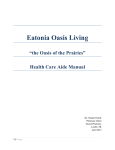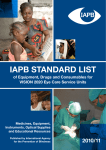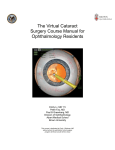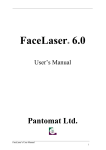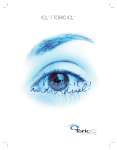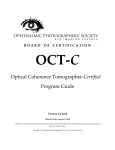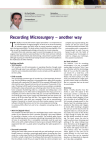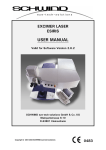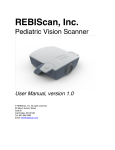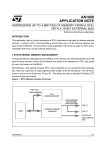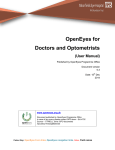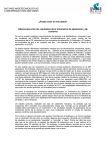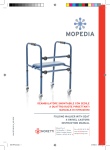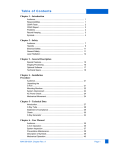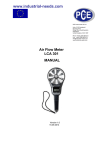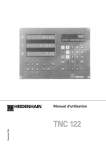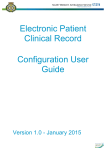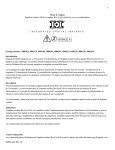Download COA Study Guide for Free - The Ophthalmic Technician
Transcript
Contents 1 Ophthalmic Patient Services & Education 1.1 Patient Education . . . . . . . . . . . . . . 1.1.1 Oculoplastic . . . . . . . . . . . . . . 1.1.2 Cornea . . . . . . . . . . . . . . . . 1.1.3 Oculomotor . . . . . . . . . . . . . . 1.1.4 Cataracts . . . . . . . . . . . . . . . 1.1.5 Glaucoma . . . . . . . . . . . . . . . 1.1.6 Retina . . . . . . . . . . . . . . . . . 1.2 Systemic & Ocular Diseases . . . . . . . . . 1.2.1 Diabetes . . . . . . . . . . . . . . . . 1.2.2 Hypertension . . . . . . . . . . . . . 1.2.3 Graves disease . . . . . . . . . . . . 1.3 Systemic & Ocular Diseases . . . . . . . . . 1.4 Anatomy & Physiology . . . . . . . . . . . . 1.5 Safety Glasses . . . . . . . . . . . . . . . . . 1.6 Patient Instruction . . . . . . . . . . . . . . 1.6.1 Medication . . . . . . . . . . . . . . 1.6.2 Tests . . . . . . . . . . . . . . . . . . 1.6.3 Procedures & Treatments . . . . . . 1.6.4 Eye Dressings . . . . . . . . . . . . . 1.6.5 Patient Flow . . . . . . . . . . . . . 1.7 Triage . . . . . . . . . . . . . . . . . . . . . 1.8 Forms & Manuals . . . . . . . . . . . . . . . 1.9 Vital Signs . . . . . . . . . . . . . . . . . . 1.10 CPR . . . . . . . . . . . . . . . . . . . . . . 2 History Taking 2.1 General History . . . . . . 2.2 Presenting Complaint . . 2.3 Past Ocular History . . . 2.4 Past Medical History . . . 2.4.1 Medical Conditions 2.4.2 Past Surgeries . . 2.5 Medications . . . . . . . . 2.6 Social History . . . . . . . 2.7 Family History . . . . . . . . . . . . . . . . . . . . . . . . . . . . . . . . . . . . . . . . . . . . . . . . . . . . . . . . . . . . iii . . . . . . . . . . . . . . . . . . . . . . . . . . . . . . . . . . . . . . . . . . . . . . . . . . . . . . . . . . . . . . . . . . . . . . . . . . . . . . . . . . . . . . . . . . . . . . . . . . . . . . . . . . . . . . . . . . . . . . . . . . . . . . . . . . . . . . . . . . . . . . . . . . . . . . . . . . . . . . . . . . . . . . . . . . . . . . . . . . . . . . . . . . . . . . . . . . . . . . . . . . . . . . . . . . . . . . . . . . . . . . . . . . . . . . . . . . . . . . . . . . . . . . . . . . . . . . . . . . . . . . . . . . . . . . . . . . . . . . . . . . . . . . . . . . . . . . . . . . . . . . . . . . . . . . . . . . . . . . . . . . . . . . . . . . . . . . . . . . . . . . . . . . . . . . . . . . . . . . . . . . . . . . . . . . . . . . . . . . . . . . . . . . . . . . . . . . . . . . . . . . . . . . . . . . . . . . . . . . . . . . . . . . . . . . . . . . . . . . . . . . . . . . . . . . . . . . . . . . . . . . . . . . . . . . . . . . . . . . . . . . . . . . . . . . . . . . . . . . . . . . . . . . . . . . . . . . . . . . . . . . . . . . . . . . . . . . . . . . . . . . . . . . . . . . . . . . . . . . . . . . . . . . . . . . . . . . . . . . . . . . . . . . . . . . . . . . . . . . . . . . . . . . . . . . . . . . . . . . . . . 1 3 3 3 3 4 4 5 5 5 6 6 6 6 7 7 7 7 7 7 7 8 9 9 9 . . . . . . . . . 10 11 11 11 12 12 12 13 13 14 iv CONTENTS 3 Pharmacology 3.1 Ocular Medicines (Instilling and Identifying) . . . 3.2 Instilling . . . . . . . . . . . . . . . . . . . . . . . . 3.3 Identifying . . . . . . . . . . . . . . . . . . . . . . . 3.3.1 Injected vs Topical vs Systemic . . . . . . . 3.3.2 Color Codes for Topical Ocular Medications 3.4 Educate Patients on Medications . . . . . . . . . . 3.5 Drug Reactions . . . . . . . . . . . . . . . . . . . . . . . . . . . . . . . . . . . . . . . . . . . . . . . . . . . . . . . . . . . . . . . . . . . . . . . . . . . . . . . . . . . . . . . . . . . . . . . . . . . . . . . . . . . . . . . . . . . . . . 15 16 16 16 16 17 17 18 4 Supplemental Skills 4.1 Intraocular Lens Power Calculation 4.2 Anterior Chamber Depth . . . . . 4.3 Pachymetry . . . . . . . . . . . . . 4.4 Calibrate Biometry Instruments . . 4.5 Tear Tests . . . . . . . . . . . . . . 4.6 Glare Testing . . . . . . . . . . . . 4.7 Color Vision Testing . . . . . . . . 4.8 Contact A-Scan . . . . . . . . . . . 4.9 Laser Interferometry (IOL Master) . . . . . . . . . . . . . . . . . . . . . . . . . . . . . . . . . . . . . . . . . . . . . . . . . . . . . . . . . . . . . . . . . . . . . . . . . . . . . . . . . . . . . . . . . . . . . . . . . . . . . . . . . . . . . . . . . . . . . . . . . . . . . . 19 20 20 20 21 21 21 21 22 22 5 Visual Assessment 5.1 Visual Acuity . . . . . . . . . . . . . . . . . . . . . . . . . . . . . . . . . . . 5.2 Potential Acuity Meter . . . . . . . . . . . . . . . . . . . . . . . . . . . . . . 5.3 Pinhole Acuity . . . . . . . . . . . . . . . . . . . . . . . . . . . . . . . . . . 23 24 25 25 6 Assisting In Surgical Procedures 6.1 General . . . . . . . . . . . . . . 6.2 Instrument Preparation . . . . . 6.3 Refractive Surgery . . . . . . . . 6.4 Sterile Fields . . . . . . . . . . . 6.5 Aseptic Technique . . . . . . . . 6.6 Nonrefractive Laser Therapy . . 6.7 Intraocular Injections . . . . . . 6.8 Sterilization . . . . . . . . . . . . 6.9 Site Identification . . . . . . . . . 6.10 Laser Safety . . . . . . . . . . . . 6.11 Assist with Procedures . . . . . . . . . . . . . . . . . . . . . . . . . . . . . . . . . . . . . . . . . . . . . . . . . . . . . . . . . . . . . . . . . . . . . . . . . . . . . . . . . . . . . . . . . . . . . . . . . . . . . . . . . . . . . . . . . . . . . . . . . . . . . . . . . . . . . . . . . . . . . . . . . . . . . . . . . . . . . . . . . . . . . . . . . . . . . . . . . . . . . . . . . . . . . . . . . . . . . . . . . . . . . . . . . . . . . . . . . . . . . . . . . . . . . . . . . . . . . . . . . . . . . . . . . . . . . . . . . . . . . . . . . . . . . . 26 27 27 27 28 28 28 29 29 29 30 30 7 Refractometry 7.1 Refractive Errors . . . . . 7.2 Lenses . . . . . . . . . . . 7.3 Automated Refractometry 7.4 Manifest Refractometry . . . . . . . . . . . . . . . . . . . . . . . . . . . . . . . . . . . . . . . . . . . . . . . . . . . . . . . . . . . . . . . . . . . . . . . . . . . . . . . . . . . . . . . . . . . . . . . . . 31 32 32 32 33 8 Medical Ethics, Legal, and Regulatory Issues 8.1 Third-Party Coding . . . . . . . . . . . . . . . . . . 8.2 Government and Institutional Rules and Regulations 8.3 Quality Assurance . . . . . . . . . . . . . . . . . . . 8.4 Ethical and Legal Standards . . . . . . . . . . . . . . 8.5 Scribing . . . . . . . . . . . . . . . . . . . . . . . . . . . . . . . . . . . . . . . . . . . . . . . . . . . . . . . . . . . . . . . . . . . . . . . . . . . . . . . . . . . . . . . . . . 34 35 35 35 35 36 . . . . . . . . . . . . . . . . . . . . . . . . . . . . . . . . . . . . . . . . . . . . . . . . . . . . . . . . . . . . . . . . . . . . . . . . . . . . . . . . . . . . . . . . . . . . . . . . . CONTENTS 8.6 8.7 8.8 v Confidentiality . . . . . . . . . . . . . . . . . . . . . . . . . . . . . . . . . . Informed Consent . . . . . . . . . . . . . . . . . . . . . . . . . . . . . . . . . Insurances . . . . . . . . . . . . . . . . . . . . . . . . . . . . . . . . . . . . . 36 36 36 9 Equipment Maintenance & Repair 9.1 Instrument Identification . . . . . . . . . . . . . . . . . . . . . . . . . . . . . 9.1.1 Instruments . . . . . . . . . . . . . . . . . . . . . . . . . . . . . . . . 9.2 Cleaning Instruments . . . . . . . . . . . . . . . . . . . . . . . . . . . . . . . 37 38 38 38 10 Tonometry 10.1 Goldmann Applanation Tonometer 10.1.1 Clean . . . . . . . . . . . . 10.1.2 Disinfect . . . . . . . . . . . 10.1.3 Calibrate . . . . . . . . . . 10.1.4 Measuring . . . . . . . . . . 10.2 Complications . . . . . . . . . . . . 10.3 Other Tonometry Methods . . . . 10.4 Intraocular Pressure Dynamics . . . . . . . . . . 39 40 40 40 40 41 41 41 42 11 Visual Fields 11.1 Amsler Grid . . . . . . . . . . . . . . . . . . . . . . . . . . . . . . . . . . . . 11.2 Confrontation Fields . . . . . . . . . . . . . . . . . . . . . . . . . . . . . . . 11.3 Automated Perimetry . . . . . . . . . . . . . . . . . . . . . . . . . . . . . . 43 44 44 44 12 Pupillary Assessment 12.1 Measure . . . . . . . . . . . . . . . . . . . . . . . . . . . . . . . . . . . . . . 12.2 Compare . . . . . . . . . . . . . . . . . . . . . . . . . . . . . . . . . . . . . . 12.3 Evaluate . . . . . . . . . . . . . . . . . . . . . . . . . . . . . . . . . . . . . . 46 47 47 47 13 Lensometry 13.1 Automated Lensometry 13.2 Manual Lensometry . . 13.2.1 Add Power . . . 13.2.2 Prism . . . . . . . . . . . . . . . . . . . . . . . . . . . . . . . . . . . . . . . . . . . . . . . . . . . . . . . . . . . . . . . . . . . . . . . . . . . . . . . . . . . . . . . . . . . . . . . . . . . . . . . . . . . . . . . . . . . . . . . . . . 48 49 49 50 50 14 Keratometry 14.1 Corneal Curvature . 14.1.1 Astigmatism 14.2 Keratometry . . . . 14.2.1 Calibration . . . . . . . . . . . . . . . . . . . . . . . . . . . . . . . . . . . . . . . . . . . . . . . . . . . . . . . . . . . . . . . . . . . . . . . . . . . . . . . . . . . . . . . . . . . . . . . . . . . . . . . . . . . . . . . . . . . . . 52 53 53 53 54 movements . . . . . . . . . . . . . . . . . . . . . . . . . . . . . . . . . . . . . . . . . . . . . . . . . . . . . . . . . . . . . . . . . . . . . . . . . . . . . . . . . . . . . . . . . . . . . . . . . . . . . . . . . . . . . . . . . . . . . . . . . . . . . . . . . . . . . . . . . 55 56 56 56 57 57 57 . . . . . . . . 15 Ocular Motility 15.1 Introduction to muscles & muscle 15.2 Versions & Ductions . . . . . . . 15.3 Tropias & Phorias . . . . . . . . 15.4 Cover Tests . . . . . . . . . . . . 15.5 Stereoacuity . . . . . . . . . . . . 15.6 Nystagmus . . . . . . . . . . . . . . . . . . . . . . . . . . . . . . . . . . . . . . . . . . . . . . . . . . . . . . . . . . . . . . . . . . . . . . . . . . . . . . . . . . . . . . . . . . . . . . . . . . . . . . . . . . . . . . . . . . . . . . . . . . . . . . . . . . . . . . . . . . . . . . . . . . . . . . . . . . . . . . . . . . . . . . . . . . . . . . . . . . . . . . . . . . . . vi CONTENTS 16 Ophthalmic Imaging 16.1 Slit-Lamp/Anterior Segment Photography . 16.2 Fundus Photography . . . . . . . . . . . . . 16.3 External Photography . . . . . . . . . . . . 16.4 Diagnostic/Standardized A-Scan . . . . . . 16.5 Corneal Topography . . . . . . . . . . . . . 16.6 Scanning Laser Tests for Glaucoma/Retina . . . . . . 58 59 59 59 59 59 60 17 Spectacle Skills 17.1 Introduction to lenses . . . . . . . . . . . . . . . . . . . . . . . . . . . . . . 17.2 Transposing . . . . . . . . . . . . . . . . . . . . . . . . . . . . . . . . . . . . 17.2.1 Spherical Equivalent . . . . . . . . . . . . . . . . . . . . . . . . . . . 61 62 62 62 18 Contact Lenses 18.1 Measure . . . . . . . . . . . . . . . . . . . . 18.2 Patient Instruction . . . . . . . . . . . . . . 18.2.1 Pathology from Contact Lens Misuse 18.3 Fitting . . . . . . . . . . . . . . . . . . . . . 18.3.1 Fitting: Soft Contacts . . . . . . . . 18.3.2 Fitting: Hard Contacts . . . . . . . 18.4 PMMA Lenses (Polymethylmethacrylate) . 18.5 Bandage Contact Lenses . . . . . . . . . . . . . . . . . . . 64 65 65 66 66 66 66 67 67 19 Microbiology 19.1 Office Antisepsis . . . . . . . . . . . . . . . . . . . . . . . . . . . . . . . . . 19.2 Universal Precautions . . . . . . . . . . . . . . . . . . . . . . . . . . . . . . 68 69 69 20 Review of Ocular Diseases 20.1 Orbit . . . . . . . . . . . . 20.2 Extraocular Muscles . . . 20.3 Eyelids . . . . . . . . . . . 20.4 Lacrimal Apparatus . . . 20.5 Abnormalities of the Eye . 20.6 Cornea & Sclera . . . . . 20.7 Anterior Chamber . . . . 20.8 Uveal Tract . . . . . . . . 20.9 Crystalline Lens . . . . . 20.10Vitreous . . . . . . . . . . 20.11Retina . . . . . . . . . . . 20.12Optic Nerve . . . . . . . . 70 70 70 71 71 71 71 71 72 72 72 72 72 21 Practice Test . . . . . . . . . . . . . . . . . . . . . . . . . . . . . . . . . . . . . . . . . . . . . . . . . . . . . . . . . . . . . . . . . . . . . . . . . . . . . . . . . . . . . . . . . . . . . . . . . . . . . . . . . . . . . . . . . . . . . . . . . . . . . . . . . . . . . . . . . . . . . . . . . . . . . . . . . . . . . . . . . . . . . . . . . . . . . . . . . . . . . . . . . . . . . . . . . . . . . . . . . . . . . . . . . . . . . . . . . . . . . . . . . . . . . . . . . . . . . . . . . . . . . . . . . . . . . . . . . . . . . . . . . . . . . . . . . . . . . . . . . . . . . . . . . . . . . . . . . . . . . . . . . . . . . . . . . . . . . . . . . . . . . . . . . . . . . . . . . . . . . . . . . . . . . . . . . . . . . . . . . . . . . . . . . . . . . . . . . . . . . . . . . . . . . . . . . . . . . . . . . . . . . . . . . . . . . . . . . . . . . . . . . . . . . . . . . . . . . . . . . . . . . . . . . . . . . . . . . . . . . . . . . . . . . . . . . . . . . . . . . . . . . . . . . . . . . . . . . . . . . . . . . . . . . . . . . . . . . . . . . . . . . . . . . . . . . . . . . . . . . . . . . . . . . . . . . . . . . . . . . . . . . . . . . . . . . . 73 Preface This book may be bought from theophthalmictechnician.com. The purpose of me writing this guide is three fold. (1) A study guide should be high-yield, not filled with unnecessary information. (2) A study guide should give the reader opportunity to be tested on material that is learned to increase retention and learning. (3) A study guide should be inexpensive. Textbook overview The chapters of this book are as follows: 1. Ophthalmic Patient Services & Education. The basic surgeries in ophthalmology. An understanding of some anatomy. This section also samples a few topics from later chapters. It is suggested that you read review of Ocular Diseases ??-??before diving in. 2. History Taking. The basic principles of history taking. What questions to ask. What are important facts that come up during dialogue between you and the patient. 3. Pharmacology. Introduction to the ophthalmic medications. This chapter also includes information on instilling medications. 4. Visual Assessment. General rules for assessing a patients vision and how to record what the patient sees. It will also be necessary to know how to convert from metric units for the exam. 5. Assisting In Surgical Procedures. Knowing what different instruments are and how to use them are important in assisting in surgical procedures. 6. Refractometry. Obtaining a manifest refraction in both plus and minus cylinder. 7. Medical Ethics, Legal, and Regulatory Issues. An introduction to legal issues within the scope of ophthalmic assisting. 8. Equipment Maintenance & Repair. An introduction to maintaining instruments. 9. Tonometry. How to obtain eye pressure. Knowing different methods for obtaining IOP and understanding those measurements. 10. Visual Fields. Know what a visual field is and the basics of common visual pathway defects. 11. Pupillary Assessment. An introduction to assessing pupillary movement. Knowing how to find afferent pupillary defects. vii viii CONTENTS 12. Lensometry. Knowing the difference between manual lensometry and automatic lensometry. Also, how to obtain manual lensometry 13. Keratometry. General knowledge of eye curvature and how to obtain keratometry manually. 14. Ocular Motility. An introduction to eye movement and the six muscles involved in ocular motility. 15. Ophthalmic Imaging. The differences between ophthalmic imaging equipment and their uses. 16. Spectacle Skills. An introduction to spectacles. Their components and types. 17. Contact Lenses. An introduction modern contact lenses. Comparing modern contact lenses and safety precautions. 17. Microbiology. Common microbiology related to the eye and how to protect against infection within the scope of ophthalmology. Bonus. Review of Ocular Diseases. An general introduction to ocular diseases. Practice Test. A practice test to aid in preparing for the COA exam. The COA Study Guide was written in the order of most weighted to least weighted material. This means that the first chapters are the chapters that will have the most questions on the exam. As I wrote this guide I realized that this may not be the optimal way to study since the most weighted sections pull from other sections of the book. To this day I still think that this is the best way to organize the information even though it may require the reader to reference a chapter later in the book while studying the first couple chapters. Examples, exercises, and appendices Examples and within-chapter exercises throughout the textbook may be identified by their distinctive bullets: Example 0.1 Large filled bullets signal the start of an example. Full solutions to examples are provided and often include an accompanying table or figure. J Exercise 0.2 Large empty bullets signal to readers that an exercise has been inserted into the text for additional practice and guidance. Students may find it useful to fill in the bullet after understanding or successfully completing the exercise. Solutions are provided for all within-chapter exercises in footnotes.1 1 Full solutions are located down here in the footnote. CONTENTS ix Why did I write this book The day came when it was time for me to study for the COA. I wanted to give myself about 2-3 months to study. I heard that my employer had some great study material and I was anxious to get my hands on it and started studying. I quickly realized that this was not going to be as straightforward as I thought. Though the material was very good and comprehensive it was not geared for passing the COA. When I asked my co-workers how they studied they showed me their books. They highlighted a few chapters here and there that they studied, but they never read the whole book. Every book I came across either had a lot of practice questions, but lacked background information or the text would immerse the reader in background information, but not give enough practice questions. That did not discourage me I still used many sources to study for the exam. After a while I thought that it was a little ridiculous that I was using a combination of 4 books to study for this one exam, but I pushed through it and passed the COA Exam. After passing the test I compiled my study notes and added everything I could think of to pack this study guide with the most essential information for passing the exam. This is what I came up with. This is the study guide that I wish I had. Study hard and good luck on your exam. I know you can pass! Acknowledgements This project would not be possible without the technicians and doctors that trained me and were patient with me. I also extend a thank you to all those who purchased earlier, rough, versions of this guide. The profits from those early days gave me the resources to put this current edition together. Work Cited Stein, H. A. (20122013). The ophthalmic assistant a text for allied and associated ophthalmic personnel (9th ed.). Philadelphia: Elsevier Mosby. Ledford, J. K. (2012). Certified ophthalmic assistant exam review manual(3rd ed.). Thorofare, NJ: SLACK. Newmark, E. (2012). Ophthalmic medical assisting: an independent study course. (5th ed.). San Francisco, CA: American Academy of Ophthalmology. Stein, H. A., Stein, R. M. (2006). The ophthalmic assistant: a text for allied and associated ophthalmic personnel (8th ed.). Philadelphia: Elsevier Mosby. Root, T. (2012). OphthoBook. United States: amazon.com]. Introduction I wanted to use this indtroduction to go over some of the basic questions that I had when I was preparing for the exam. What is the COA Certification? The Certified Ophthalmic Assistant (COA) certification is the first step in the ophthalmic assisting profession. It shows to future employers that you have worked in ophthalmology for at least 6 months and could pass a test on basic ophthalmology. It is a worthwhile endeavour and may result in a higher chance of getting a job and, at least in my case, a pay increase. How to become a COA There are three ways to become a COA: (1) Approved Independent Study Course with 1,000 hours of work experience This is the most common way to become a COA. You have to work for an ophthalmologist for 1000 hours (6 months full time), take an independent course, and pass the exam. There are only two independent courses that I am aware of. First, is the JCAHPO Career Advancement Tool (JCAT). The second is the American Academy of Ophthalmology Independent Study Course.You will also have to be sponsored by a doctor before you can set a test date. The cost is $300 for the initial exam, $250 for the first retake if you fail, and $150 for the third retake. (2) A Non-Clinical Training Program with 500 hours of work experience If you have done some formal education in a Training Program then you only need 500 hours of work experience. (3) Clinical Formal Training Program with 0 hours of work experience Formal Training programs are more common if you want to become a COT or a COMT. There are some programs that offer COA training, but most COAs just work under an ophthalmologist. More more information see JCAHPO Criteria for Certification on page 10. The sections in the guide was made strictly from criteria described in this packet. How do I use this guide? I suggest reading through all of the material and going through the practice questions in the back of the book. I included concept checklists at the beginning of every sections. Be x CONTENTS xi able to check off each of the boxes. These checklists highlight concepts that are important to retain and review before the exam. What is the Exam Like? (1) How many questions are on the exam? The test is 200 scored questions with the addition of 10-25 unscored questions. JCAHPO uses unscored questions to determine if they will be good questions for future tests. (2) How much time do I get to take the exam? The exam is 3 hours. (3) Where do I take the exam? The test is taken at a certified testing center. I took my test at a Pearson VUE testing center. (4) Is the test on paper or computer? The COA exam is on the computer. What is nice about the computer based test is that you can flag answers you dont know and go back to them later. (5) How long do I need to study and how do I prepare? This will be different for everyone. I suggest that you study for less than three months. I have known some people to do it in as little as two weeks. Some people will retain information better than others. The best way to retain information is to repeat it. This is especially true for the subjects that you dont like of that you are not so familiar with.The table I made on the next page is very similar to how I studied. I studied with the most heavily weighted content first then worked my way down. There were 2 or 3 sections that I felt uncomfortable on and wanted to repeat. This layout should get you through all of the material in about 2 months and still give you some time to repeat sections or to miss a day. This will give you enough time to soak up all the information you will need for the exam. xii CONTENTS Study Content & Exam Percent Content Area Ophthalmic Patient Services & Education History Taking Pharmacology Supplemental Skills Visual Assessment Assisting in Surgical Procedures Refractometry Medical Ethics, Legal & Regulatory Issues Equipment Maintenance & Repair Tonometry Visual Fields Pupillary Assessment Lensometry Keratometry Ocular Motility Ophthalmic Imaging Spectacle Skills Contact Lenses Microbiology Exam Percent COA 16 8 8 8 8 7 6 6 4 4 4 3 3 3 3 3 3 2 2 Days to Study 7 2 1 2 2 3 3 2 2 2 2 1 2 1 2 2 1 3 1 Chapter 1 Ophthalmic Patient Services & Education This section is the largest and most difficult section. I put this chapter first because it is good to get the largest section out of the way, but in reality, the material in this chapter references material from future chapters. You may have to jump around the book a little to get the most out of this chapter. Concept Checklist: 1. Have a firm grasp on the following surgeries: (a) Oculoplastic- Ptosis, blepharoplasty, enucleation, evisceration (b) Cornea- Keratoplasty, pterygium, LASIK, LASEK, PRK, PTK, RK (c) Oculoplastic- Ptosis, blepharoplasty, enucleation, evisceration (d) Oculomotor- Resection and recession (e) Cataracts- Know symptoms, corneal topography, BAT, PAM (f) Glaucoma- Trabeculectomy and Iridotomy (g) Retina- Vitrectomy, photocoagulation, and injections 2. Understand the effect of diabetes, hypertension and graves disease on the eyes. 3. Read Review of Ocular Diseases 4. Review Pharmacology 5. Review Supplemental Skills 6. Review Visual Fields 7. Review Ocular Motility 8. Review Assisting In Surgical Procedures 9. Know all anatomy terms. 10. Know which patients need safety glasses. 11. Know when pressure patches and eye shields are appropriate. 12. Understand patient flow 1 2 CHAPTER 1. OPHTHALMIC PATIENT SERVICES & EDUCATION 13. Know the difference between emergencies, urgent, semi-urgent, and non urgent cases when triaging. 14. Memorize the normal ranges for vital signs. 15. Know how to perform CPR on adults and infants. 1.1. PATIENT EDUCATION 1.1 3 Patient Education: Surgery There are a lot of surgeries that patients have to have in ophthalmology. When patients have questions, you are expected to help answer their questions. The COA exam reflects this. It will expect you to know the differences among the many surgeries. 1.1.1 Oculoplastic Oculoplastics have to do with the function and cosmetics of the external features of the eye. If a patient has ptosis, droopy eyelids, the surgeon will perform a surgery to raise the eyelids. If a patient has extra skin on the upper eyelids, dermatochalasis, the physician will perform a blepharoplasty to remove excess skin from the lids. Oculoplastic surgeons will also perform enucleations and eviscerations. Enucleation is the removal of the entire eyeball leaving only the muscles and orbit intact. Evisceration is the removal of the entire contents of the eye leaving the sclera. Memorization Trick: Enucleation & Evisceration Enucleation nukes the entire eye. Evisceration leaves a visible sclera. J Exercise 1.1 A patient states that he had a blepharoplasty. What condition did he need corrected? 1 1.1.2 Cornea Keratoplasty is when a dying part of the cornea is replaced with donated corneal tissue. This is also known as corneal grafting or a corneal transplant. Pterygium Surgery is the removal of tissue which grows over the cornea. Refractive surgeries - Read more on Assisting in Surgical Procedures under the section refractive surgery . Be able to describe LASIK, LASEK, PRK, PTK, and RK. REFRENCE NEEDED FOR SUGICAL PROCEDURES. 1.1.3 Oculomotor Physicians can correct strabismus crossed-eyes. They do this by either strengthening a muscle by doing a resection or by weakening a muscle which is a recession. Resections are performed by shortening the tendon. A recession is performed by attaching the muscle further back on the eye. J Exercise 1.2 As you are reading a patients medical record you see that the patient has had a resection. Does this mean that the muscle was shortened or attached further back on the eye? 2 1A blepharoplasty is a procedure used to correct dermatochalasis. are performed by shortening the tendon. 2 Resections 4 CHAPTER 1. OPHTHALMIC PATIENT SERVICES & EDUCATION 1.1.4 Cataracts Cataracts are very common in ophthalmology. It is also common to see questions related to cataracts on the exam. Symptoms: Glare Patients will often say that they see intense glare from oncoming traffic while driving at night. Or see glare in a room with low lights. Halos Halos are rings of light around a source of light. This is another common complaint. Patients will state that they see halos around headlights. Special tests related to cataract surgery: Corneal Topography This makes a typographical map of the cornea which gives the provider information about the shape and curvature of the cornea. Surgeons use this while planning for cataract surgery. PAM (Potential Acuity Meter) estimates the vision a patient may have after cataract surgery. The PAM is a device which attaches to a slit lamp. When the patient looks into the PAM, a visual acuity chart is seen. The visual acuity chart lights up, helping the patient see it through media opacities. BAT (Brightness Acuity Test) gives the most accurate idea of a patients visual disability. If a patient has a dense cataract they will read worse when testing visual acuity with the BAT. Many insurances require that a patient have a visual acuity 20 of 20 40 or 50 before they will cover the cataract surgery. The BAT helps achieve this goal. A patient with a dense cataract may have a visual acuity of 20 25 , but with the BAT see 20 or considerably less. 60 1.1.5 Glaucoma Glaucoma is death of the optic nerve. High eye pressure is associated with glaucoma. A decrease in aqueous outflow causes eye pressure to increase. Important Process: Flow of Aqeuous. The flow of fluid, aqueous is important when understanding glaucoma related problems. The flow of fluid is as follows: Aqueous is produced by the ciliary body, flows through the pupil, over the iris, and out through the trabecular meshwork. Open Angle Glaucoma - Open angle glaucoma is the most common form of glaucoma. It occurs when the trabecular meshwork is not functioning properly. It is like a clogged drain. The aqueous cant filter out effectively so more pressure builds up. To treat open angle glaucoma the physician will first start with drops to lower eye pressure. He will then move to a trabeculectomy. A trabeculectomy provides an alternate route for fluid to travel. A laser is used to poke a hole in the limbus. The aqueous then flows underneath the conjunctiva. This area is a bleb. Remember, P ressure = F orce/Area. This surgery increases area which decreases pressure. Closed Angle Glaucoma - There is an angle that is made between the cornea and the iris. When this angle shrinks, fluid cant drain out of the trabecular meshwork. This increases eye pressure. To treat Closed Angle Glaucoma the surgeon will do an 1.2. SYSTEMIC & OCULAR DISEASES 5 iridotomy. An iridotomy is a hole made in the iris with a laser. This decreases eye pressure. Example 1.3 Describe the flow of aqueous from memory. Aqueous is produced by the ciliary body, flows through the pupil, over the iris, and out through the trabecular meshwork. J Exercise 1.4 Is open angle glaucoma a problem with too much fluid entering the eye or not enough fluid leaving the eye?3 1.1.6 Retina Vitrectomy If a patient has had a vitreous hemorrhage the surgeon may consider performing a vitrectomy. A vitrectomy is the removal of vitreous from the eye. The physician may also decide to do a vitrectomy if he wants to do retinal surgery. When a vitrectomy is performed, oil or a gas bubble is placed inside the eye to help hold the shape of the eye. Photocoagulation When a patient has bleeding in the back of the eye it can be stopped with photocoagulation.Photocoagulation is the use of a laser to coagulate blood to stop bleeding. Patients with advanced diabetic retinopathy may need photocoagulation. Anti-VEGF injections VEGF(Vascular Endothelial Growth Factor) causes new blood vessels to grow. In most cases this is a good thing, but when this occurs in the retina it can cause vision problems. Patients that are experiencing advanced neovascularization (new blood vessel growth) may receive anti-VEGF treatments which stop neovascularization. 1.2 Systemic & Ocular Diseases: System 1.2.1 Diabetes High blood sugar causes problems in both the lens and the retina. Glucose is deposited in the lens. The high concentration of glucose in the lens causes a large osmolarity gradient between the concentration of glucose in the aqueous humor outside of the lens and the concentration of the glucose in the lens. To compensate for this high osmolarity gradient, water moves from the aqueous to the lens which causes the lens to swell. The swollen lens causes blurry vision. In the retina, two types of diabetic retinopathy (retinal death) is seen, NPDR and PDR. NPDR (Non Proliferative Diabetic Retinopathy) Proliferation refers to the growth of new blood vessels. With NPDR their is no blood vessel growth, but the physician will see dots. These dots are small aneurysms(broken vessels) on the retina. PDR (Proliferative Diabetic Retinopathy) - This is a more serious form of diabetic retinopathy. PDR is treated with a procedure called scatter laser treatment. The scatter laser makes over 1,000 burns around the peripheral areas of the retina. This 3 Open angle glaucoma occurs when the trabecular meshwork is not acting as a good drain for aqueous. It is a problem with no enough fluid leaving the eye. 6 CHAPTER 1. OPHTHALMIC PATIENT SERVICES & EDUCATION causes blood vessels to shrink. PDR may also result in macular edema, swelling of the macula. If this swelling occurs the physician may use a focal laser to shrink abnormal blood vessels. 1.2.2 Hypertension Hypertension causes ischemia (blood clots) both systematically and in the retina. When an examiner sees cotton wool spots he is referring to areas of ischemia on the retina. 1.2.3 Graves disease Graves disease is an autoimmune disease which affects the thyroid. It also affects the eyes causing bulging of the eyes, exophthalmos. J Exercise 1.5 How does Diabetes cause the lens to swell?4 J Exercise 1.6 Which autoimmune disease is related to exophthalmos?5 1.3 Systemic & Ocular Diseases: Ocular This section is covered sufficiently in Review of Ocular Diseases 1.4 Anatomy & Physiology Memorize this list of structures. Be able to locate these structures in the eye. 1. Anterior Chamber 10. Descemets Membrane 20. Nasolacrimal Duct 2. Anterior Segment 11. Endothelium 21. Nasolacrimal Sac 3. Aqueous & Vitreous Humor 12. Epithelium 22. Optic Nerve 4. Bowmans Layer 14. Iris 5. Bulbar Conjunctiva 15. Lacrimal Gland 6. Canaliculus 16. Lateral Canthus 7. Caruncle 17. Lens 26. Punctum 8. Ciliary Body 18. Macula 27. Sclera 9. Cornea 19. Medial Canthus 28. Stroma 13. Fovea 23. Palpebral Fissure 24. Plica 25. Posterior Chamber 4 High concentrations of glucose in the lens creates a concentration gradient. Water flows into the lens to balance the concentration causes the lens to swell. 5 Graves disease 1.5. SAFETY GLASSES 1.5 7 Safety Glasses Safety glasses can be prescribed for people who weld, are at risk for chemical contact with the eye, and monocular patients. Safety lenses are lenses which are shatter resistant. Example 1.7 Explain why a monocular patient would want safety glasses. Monocular patients ought to be given safety glasses to protect the one eye that they have left. 1.6 Patient Instruction Patient instruction is an important part of ophthalmic care especially when it applies to instruction related to medication and ophthalmic testing. 1.6.1 Medication For this section I would recommend looking at Pharmacology which covers this section sufficiently. Instruct patients to instill topical eye drops and ointments by pulling down the lower lid and looking up. Applying pressure to the lacrimal ducts will decrease the amount of solution absorbed by the body. 1.6.2 Tests This is an overlap section. Follow the links. Supplemental Skills, Visual Fields, and Cover Tests. Look under cover tests and stereoacuity. 1.6.3 Procedures & Treatments I lumped these sections together because all of this information is covered in Assisting In Surgical Procedures. 1.6.4 Eye Dressings Pressure patches are used to help the eye heal. The difference between a pressure patch and an eye shield is that a pressure patch keeps the eye from blinking. To apply a pressure patch, the technician places a patch to the eye and tapes the patch from forehead to cheek. If the patient can blink their eye after the patch has been applied then it must be redone until the patient can no longer open his eye. An eye shield is used to protect the eye. Eye shields are given to patients who have had surgeries. This keeps the eye protected from external forces. 1.6.5 Patient Flow When guiding a low vision patient to the exam room offer your arm. Have the patient hold near your elbow as you guide them to the room. If the provider is running behind inform the patients. 8 CHAPTER 1. OPHTHALMIC PATIENT SERVICES & EDUCATION 1.7 Triage To triage means to determine the urgency of a case. You determine when a patient ought to be seen by an eye care provider. Emergencies: Must be seen within minutes 1. Chemical burns 2. Retinal artery occlusions 3. Penetrating eye injuries 4. Sudden vision loss Urgent: Must be seen within the same day 1. Narrow angle closure glaucoma 2. Corneal ulcer 3. Foreign body 4. Corneal abrasion 5. Acute iritis 6. Retinal detachment 7. Hyphema 8. Blow-out fracture Semi-urgent: Should be seen within days 1. Semi-urgent Should be seen within days 2. Optic Neuritis 3. Ocular tumors 4. Previously undiagnosed glaucoma Non urgent: Should keep regular appointment. 1. Gradual blurry vision 2. Needs new glasses Example 1.8 How would you triage corneal edema? Corneal edema would be considered an Urgent case. 6 J Exercise 1.9 How would you triage sudden vision loss? J Exercise 1.10 How would you triage sudden a patient who needs new glasses? 6 Sudden 7 New vision loss would be an emergency. glasses would be a non-urgent case. 7 1.8. FORMS & MANUALS 1.8 9 Forms & Manuals This was already covered under Medical Ethics. 1.9 Vital Signs It is expected that all health care workers know the following vital signs: Blood Pressure 90/60 120/80 mmHg Breathing 12-18 breaths/min Pulse 60-100 beats/min Temperature 97.8-99.1 degrees Fahrenheit Blood Sugar 70-92 mg/dl (fasting) 1.10 CPR Every ophthalmic technician needs to get a CPR (Cardiopulmonary Resuscitation) certification. There will be at least one question testing your knowledge on CPR on the COA exam. Adult CPR (a) Is the scene safe make sure that there are no hazards. (b) Is the victim responsive does the victim respond to a loud voice or pain? (c) Call for help Call 9-1-1 (d) Compressions 100 compressions per minute each 2 inches in depth. (e) Airway Tilt head back, lift chin to open airway. (f) Breathing Pinch the victims nose closed and give two breaths. Watch for the chest to rise and fall. Breaths delivered should be a normal breath. (g) Repeat CAB Infant CPR (a) Is the scene safe make sure that there are no hazards. (b) Is the victim responsive does the victim respond to a loud voice or pain? (c) Call for help Call 9-1-1 (d) Compressions 100 compressions per minute1 and 1/2 inches in depth. (e) Airway Tilt head back, lift chin to open airway. (f) Breathing Apply mouth to the nose and mouth of the baby. Pinching the nose on an infant is impossible to achieve and be effective. Breaths delivered should be small puffs of air. Large full breaths could damage the infants lungs. (g) Repeat CAB (Compression, Airway, Breathing) until victim breathes or help arrives. Chapter 2 History Taking History taking is an important part of the exam. It helps aid the practitioner in making a correct diagnosis. Concept Checklist: 1. Be able to define a presenting complaint. 2. Memorize the 8 parts of the HPI (History of present illness). 3. Know the difference between a sin and a symptom. 4. Know the 3 types of questions that should be covered while collecting an ocular history. 5. Know the 2 areas to cover in the medical history. 6. Know the 3 purposes of recording a list of medications and give examples of medications that fit into these purposes. 7. Know the 2 parts that are important in the social history. 8. List 3 common inheritable ocular diseases. Special tests related to cataract surgery: 10 2.1. GENERAL HISTORY 2.1 11 General History A history is obtained by asking specific questions. Some people may be harder to get histories from than others. Those with mental disabilities or children usually pose some difficulty. It is important that you hear the 2.2 Presenting Complaint The chief complaint, sometimes called the presenting complaint, is the main reason the patient is in the clinic. When obtaining information about the onset of a complaint, you need to know when the patient started to notice that something was not right and how quickly the symptoms came about. In general, a sudden onset means that the problem is more serious. CPT (seeThird-Party Coding) requires the following 8 pieces of information when collecting a History of the presenting complaint: 1. Location: Where is the problem? 2. Duration: How long have you noticed the symptoms. 3. Context: Is is associated with any other activities. 4. Modifying factors: What makes it better or worse 5. Quality: Describe the pain, Is it an ache, an itch, foreign body sensation? 6. Severity: How would you rate your pain on a scale from 1 to 10? 7. Associated Signs & Symptoms: Is it associated with a headache? 8. Timing Do symptoms come and go or are they constant? history from both the guardian/caretaker and the patient. Important Concept: Symptom or Sign A sign is something that the clinician sees such as redness or high eye pressure. A symptom is what the patient experiences like flashes, pain, or itchiness. J Exercise 2.1 List from memory the 8 peices of information required by CPT1 2.3 Past Ocular History The following are the types of questions that should be asked when obtaining an ocular history. 1 Location, Duration, Context, Modifying factors, Quality, Severity, Associated Signs & Symptoms, and Timing 12 CHAPTER 2. HISTORY TAKING Refraction These questions help the provider know why the patient is seeing at his/her current visual acuity and help the provider know what kind of changes need to be made. Examples of refraction related questions are: Does the patient have glasses? What kind of glasses do they have? How old are the glasses? Do the glasses have prism? Does the patient have contact lenses? Are they hard or soft lenses? Surgery Have they had ocular surgeries or procedures in the past? Medication These questions may help the provider know what ocular pathology the patient currently has. If the patient is taking a beta-blocker then the patient is being treated for glaucoma. If the patient is taking a steroid then the patient may be treated for some type of inflammation. Does the patient take any ocular medication? What are those medications treating? 2.4 Past Medical History The medical history can be broken down into two parts, medical conditions & surgical history 2.4.1 Medical Conditions Many systemic medical problems are relevant to ocular health. The following are examples of medical conditions that play a big role in ocular health. Hypertension - Decreased vision via arterial narrowing or retinal vein occlusion. Diabetes - Causes blurred vision via glucose entering the lens and by neovascularization (in advanced cases). Asthma - If a patient with asthma is on Albuterol and a beta blocker, which may be used to treat glaucoma, then that patient can have a bronchospasm. Autoimmune diseases - Rheumatoid Arthritis causes dry eyes. Patients with lupus may be on plaquenil and need to have their macula evaluated. Example 2.2 A glaucoma patient states she has asthma. Why is this important to document? If the patient is taking a beta blocker it may had an adverse reaction with some glaucoma drops. 2.4.2 Past Surgeries These are not just ocular surgeries, but also systemic surgeries. Common examples I have seen are stents, cholecystectomy (removal of the gallbladder), and heart bypass. Any surgery should be recorded in the patients history. 2.5. MEDICATIONS 2.5 13 Medications There are three purposes to gathering information about a patients medications: 1. Insight into ocular pathology Some medication give you a hint on the patients past ocular history and indicate a current condition such as Lumigan, which is used to treat glaucoma. Eye care providers prescribe vitamins for patients with macular degeneration. Diamox, a sulfa containing drug, is sometimes used to control glaucoma. It is important to note that many patients are allergic to sulfa. If a patients mentions that a certain medication made them break into a rash you should record that medication as an allergy. 2. Insight into systemic pathology Aspirin is a blood thinner. Patients are instructed to sometimes avoid blood thinners before surgery. Diuretics causes more fluid to leave the bloodstream. This causes the blood pressure to drop. Beta blockers are also used to treat hypertension. Flomax - Before getting cataract surgery patients should be asked if they are taking tamsulosin (Flomax). Flomax is a medication widely prescribed for urinary symptoms associated with enlargement of the prostate. An analgesic is a medication used for pain relief. 3. Medications that cause ocular pathology Medications can cause ocular problems such as plaquenil, which may cause damage to the macula. Steroids are used to treat conditions such as rheumatoid arthritis, but may increase the risk for developing cataracts and may increase IOP (Intraocular Pressure). J Exercise 2.3 A retina patient states that he is allergic to sulfa drugs. What is one drug that he should stay away from?2 J Exercise 2.4 What is the purpose of a diuretic?3 2.6 Social History Social history can be broken down into two parts. 1. Occupational setting Knowing a patients occupation is relevant. If glasses are being prescribed you need to know what their occupation is. Do they work on a computer? Do they read? Are they at risk for eye injury? These type of questions help the ophthalmologist prescribe the correct glasses for the patient. Some occupations pose a risk for trauma. Welders might get metal in the eye. Landscapers will also be at risk for foreign bodies and pterygiums. 2. Habits Does the patent drink alcohol, smoke, use recreational drugs? 2 Diamox 3 Diuretics causes more fluid to leave the bloodstream. This causes the blood pressure to drop and urine production to increase. Some people refer to these medications are water pills. 14 CHAPTER 2. HISTORY TAKING 2.7 Family History There are many disorders in ophthalmology that are inheritable. Common inheritable diseases include glaucoma, strabismus (misalignment of the eyes), and myopia. Secondary glaucoma is not inheritable. Secondary means that it was caused by something else. Chapter 3 Pharmacology The pharmacology section will test your ability to identify medication, know how to instill them, and recognize reactions to medications. Concept Checklist: 1. 2. 3. 4. 5. 6. 7. Know the steps involved in instilling eye drops. Compare and contrast injected, topical, and systemic medications. Be familiar with the color codes for ocular medications. Know the effect of anesthetics, mydriatics, and glaucoma drops. Compare and contrast solutions, suspensions, and emulsions. Be able to recognize an allergic reactions to medications. Know the importance of irrigation in the event of chemical burns. 15 16 CHAPTER 3. PHARMACOLOGY 3.1 Ocular Medicines (Instilling and Identifying) Eye drops are used in ophthalmology to: 1. Dilate the pupil 2. Numbing the eye 3. Treat Bacterial infections 4. Treat allergies 5. Treat viral infections One disadvantage of eye drops is that they do not have long contact with the eye. If the eye requires prolong treatment then an ointment is prescribed. The problem with eye ointment is that it blurs the patients vision. 3.2 Instilling Instilling eye drops is routine for the ophthalmic assistant. Though it is something that is done many times a day for the ophthalmic technician it is important to know the steps and some terminology. Important Process: Instilling Drops • Ask the patient to tilt his head back. • Ask the patient to look up. The patient may also look down to distribute the drop over the cornea, but this is only advised when absorption of the drop is not necessary as with artificial tears. • Pulling down the lower lid. • Putting the drop in the inferior fornixa of the eye. a The 3.3 3.3.1 inferior fornix is in the botom lid. Identifying Injected vs Topical vs Systemic Sometimes injections are needed to treat patients with certain disorders. Injections have several advantages over topical medication. Injections can be provided at a specific site such as in the eye or in one of the muscles of the eye. Injections take effect immediately and can be delivered in higher concentrations. One disadvantage of injections is that they are invasive Topical medications are drops placed directly on the eye. An example of a topical medication would be glaucoma drops. These drops are placed directly on the eye 3.4. EDUCATE PATIENTS ON MEDICATIONS 17 and function to open the trabecular meshwork (the drainage system of the eye) or to decrease aqueous production from the ciliary body. One advantage of topical eye drops is that many of them do not go systemic. Their actions mainly affect the eye. Systemic Medication affect the whole body. They are taken orally, by injection, or by inhaler. If a patient presents with shingles that patient may receive a systemic oral medication. If a patient has a severe reaction epinephrine, a systemic injection, is given. 3.3.2 Color Codes for Topical Ocular Medications Class Color Anti-infective Anti-inflammatory/steroid Mydriatics and cycloplegics Nonsteroidal anti-inflammatories Miotics Beta-blockers Beta-blocker combinations Adrenergic agonists Carbonic anhydrase inhibitors Prostaglandin analogues Tan Pink Red Gray Dark Green Yellow Dark Blue Purple Orange Turquoise 1 Example 3.1 A patient can’t remember what medication he is on, but he knows that the cap color is tan. What medication is he on? Tan caps signify Anti-infective drops. J 3.4 Exercise 3.2 A patient can’t remember what medication he is on, but he knows that the cap color is pink. What medication is he on? 2 Educate Patients on Medications Anesthetics After instillation of an anesthetic it is important to tell the patient to not rub their eyes. This is because patients cant feel if they are rubbing their eyes to hard. They may damage their eyes. Also, anesthetic eye drops are never prescribed for patients to take home. Patients who have had a foreign body removed may want to take anesthetic drops. This is not advised! Anesthetic drops cause corneal melting which will slow healing. Dilation (Mydriatics and cycloplegics) Patients who undergo dilation can expect to have light sensitivity and blurry vision. Near vision is affected more than distance vision. 1 The American Academy of Ophthalmology has approved the use of color codes for the caps of topical medication. 2 A Pink cap signifies Anti-inflammatory or steroid drops. 18 CHAPTER 3. PHARMACOLOGY Glaucoma Medication Patients with glaucoma are given glaucoma drops. These drops unlike drops used to treat infection, are continued until the doctor decides to change treatment. Patients may be on a scheduled drop for glaucoma for the rest of their life. These drops usually do not improved vision, but slow down or stop the progression of glaucoma. It is important to stress the importance of being faithful to glaucoma drops to slow the onset of blindness. Mixture Types: Solution, Suspension, Emulsion Solutions Solutions contain a solute dissolved in a solvent. Salt water is a solution. Proparacaine is an example of a solution used in ophthalmology. Suspension Suspension drops are not one solution. If you had a cup of muddy water over time you will see that the particles will drop to the bottom. Pred Forte is a steroid suspension. It is important to shake suspension well before using them. Emulsion An emulsion is a solution in which the components do not blend. An example of this would be vinaigrette dressing. Durezol is an emulsion. Just like you shake vinaigrette before you use it you also want to ask patients to shake an emulsion drop before they use it. Example 3.3 Which mixture type is most important to shake? A solution, suspension, or emulsion? A suspension is most important to shake every time before use. Emulsions may also need occasional shaking. J Exercise 3.4 Which mixture is most like a vinaigrette? 3.5 3 Drug Reactions Allergies There may come a time when patients receive a medication that they are allergic to. You can tell that a patient is having an allergic reaction because they may have the following symptoms:itching, redness, and swelling. Sometimes this can be so bad that it looks like the patient got hit in the face. An allergic reaction this bad is nicknamed allergic shiner. Irrigation When a harmful substance enters the eye the first thing that the provider must do is irrigate the eye.This is the case with chemical burns. 3 Emulsions? Chapter 4 Supplemental Skills Supplemental skills consist of tests that an ophthalmic assistant ought to know or perform. Concept Checklist: 1. Read Review of Ocular Diseases 2. Know the measurement that are frequently used when calculating intraocular lens power. 3. Know how to assess anterior chamber depth explain why it is important to check before dilating. 4. Know the purpose of pachymetry and how to perform it. 5. Know the difference between Schirmer s test 1 and Schirmer s test 2. 6. Know the purpose of Rose Bengal. 7. Know the importance of glare testing and why it is important as a diagnostic test before cataract surgery. 8. Know the purpose of the color vision test (Ishihara Color Test). 9. Know the purpose of the Contact A-Scan. 10. Compare and contrast the Contact A-Scan and the IOL Master. 19 20 CHAPTER 4. SUPPLEMENTAL SKILLS 4.1 Intraocular Lens Power Calculation When a surgeon performs cataract surgery he does not want to put in any lens. He needs to make an educated decision on what lens would cause the light to converge on the retina just right. To make this decision the physician needs the following information: 1. Refraction The most current manifest refraction. 2. Keratometry The curvature of the eye A-constant. The A constant that comes with the IOL Master Axial length This is the distance between the anterior and posterior poles of the eye, the distance between the tip of the cornea to the retina. 4.2 Anterior Chamber Depth The Anterior Chamber is the fluid-filled space between the posterior cornea and the lens. Evaluating anterior chamber depth is important in testing for narrow angle glaucoma. If a patient has narrow angles and dilation drops are instilled into the eye the outflow of aqueous can be shut off completely which will raise intraocular pressure and damage the optic nerve. Use three sets of data when evaluating anterior chamber depth. 1. Hyperopia- hyperopia, in some patients, causes the iris to bow-out. Normally an iris should be somewhat flat like a plate or a disk. When an iris bows-out it is shaped more like a parachute. The more positive the spherical value of their prescription the more likely they are to bow-out. When an iris bows-out it may cause constricted flow of the aqueous through the trabecular meshwork. 2. Pen Light- Shine a penlight across the eye. If the side opposite from the source of light casts a shadow that is a bad thing. that means that the iris is bowing-out. If the iris is bowed out then it needs to be checked on a slit lamp. 3. Slit Lamp- This is the ultimate test. Shine a narrow beam of light at an angle on the limbus(The area where the iris and the white of the eye meet). Two beams of light should be seen. The first beam of light is the reflection off of the cornea and the second beam of light is the reflection off of the iris. The larger the gap between these two reflections the better. If there is no gap then the patient may have narrow angles. 4.3 Pachymetry A pachymeter is used to test corneal thickness. Most corneas are about 500 micrometers. The thickness of the cornea is useful when evaluating glaucoma.To perform this test instill an anesthetic, place the probe on the center of the cornea, and hold until the measurement is complete. 4.4. CALIBRATE BIOMETRY INSTRUMENTS 4.4 21 Calibrate Biometry Instruments Biometry instruments must be calibrated. To know how to calibrate a particular biometry instrument consult the user manual. 4.5 Tear Tests 1. Schirmers test This test tests for sufficient tearing. The test is performed by putting filter paper under the lid. There are two types of Schirmers test. (a) Schirmers test 1 The patient is given anesthetic to test baseline secretions (b) Schirmers test 2 The patient is not given anesthetic to test baseline secretions + reflex secretions. Reflex tears are a response to irritation. 2. Tear Break-Up Time Tear break-up is an area of the eye that is dry caused by lack of tears. A physician will measure the time it takes for the tear film to break up. 3. Rose Bengal- This test is used on patients with dry eye. It is like fluorescein, but it binds much tighter to degenerated epithelial cells and not to living cells. This makes it a better indicator of corneal damage due to dry eyes. The one disadvantage is that it is more painful than fluorescein. Example 4.1 Which Schirmers test uses an anesthetic? Schirmers test 1 J Exercise 4.2 What is the difference between rose bengal and fluorescein? 4.6 1 Glare Testing Patients with cataracts many times complain of glare. A patient may read 20/30, but when light is shining toward the eye the patient may only be able to read the 20/60 line. If there is a large difference in vision due to glare the cause is most likely are cataract. 4.7 Color Vision Testing In our eye we have two main types of photoreceptors. These are the rods and cones. Cones are responsible for our color vision. The colors that our cones respond to are red, green, and blue. Ishihara color plates are used to test for color blindness. The most common color defects are red-green color deficiency. 1 Rose bengal binds tighter to degenerated epithelial cells. 22 CHAPTER 4. SUPPLEMENTAL SKILLS 4.8 Contact A-Scan Contact A-Scan is a regular test performed before cataract surgery. This information is needed when determining the IOL (intraocular lens) power the patient should be given. The patient is given local anesthetic then a probe is placed on the eye. This probe evaluates the axial length of the eye. The axial length of most eyes should be 23-24mm. One disadvantage to using a contact A-scan is that the axial length may be smaller than it really is due to the force of pressing the probe on the eye too hard. 4.9 Laser Interferometry (IOL Master) The IOL master, like the contact A-Scan, can measure axial length. The benefit of using the IOL master is that it is non contact which means that it does not have error due to pressing on the eye like the contact A-Scan. The IOL master uses infrared light to measure the length of the eye. The IOL master can also be used to find keratometry. Chapter 5 Visual Assessment Visual assessment is a small, but important section of the test. It will be necessary to convert acuities from feet to meters. Concept Checklist: 1. Know how to test visual acuity. 2. Know how to convert from feet to meters. 3. Compare and contrast the pinhole and the potential acuity meter (PAM). 23 24 CHAPTER 5. VISUAL ASSESSMENT 5.1 Visual Acuity Visual acuity is tested by asking the patient to read letters of different sizes. Visual Acuity Visual acuity is broken into a numerator, the top number, and the denominator, the bottom number. The numerator represents the test distance. The denominator is the number that represents what the patient can see compared to a normal eye. Example 5.1 Explain what the numerator and denominator are describing in the visual acuity of 20/20. 20/20 Means that at 20 feet the patient can see what a normal eye can see at 20 feet. Example 5.2 Explain what the numerator and denominator are describing in the visual acuity of 20/60. 20/60 Means that at 20 feet the patient can see what a normal eye can see at 60 feet. J Exercise 5.3 Explain what the numerator and denominator are describing in the visual acuity of 15/20. 1 J Exercise 5.4 Explain what the numerator and denominator are describing in the visual acuity of 20/15. 2 Important Concept: Converting Visual Acuity from feet to meters. You will also need to know how to convert any acuity to 20/x. I had a couple questions on the test which tested my ability to convert from meters to feet. These are the steps you can take to do the conversion: 1. Divide the numerator and denominator by 3. 2. Multiply the numerator and denominator by 10. Example 5.5 Convert 6/18 meters to feet. 6÷3 2 1. = 18 ÷ 3 6 2 × 10 20 2. = 6 × 10 60 J 1 15/20 2 20/15 Exercise 5.6 Is a visual acuity of 6/6 better than 20/25? Means that at 15 feet the patient can see what a normal eye can see at 20 feet. Means that at 20 feet the patient can see what a normal eye can see at 15 feet. 3 2 6÷3 = 6÷3 2 2 × 10 20 2. = 2 × 10 20 3. 6/6 = 20/20 which is better than 20/25. 1. 3 5.2. POTENTIAL ACUITY METER 25 You will also be expected to know how to document vision worse then 20/400. If the patient cant see any of the letters on the snellen chart hold up fingers and see if the patient can read them. Record the distance at which the patient could count the number of fingers you were holding. CF5 means that the patient could count fingers at 5 feet. If the patient cant count fingers then wave your hand in front of the patients eye. If the patient can tell that you are waving your hand then record that as HM. If the patient cant see your hand waving then shine a light in the patients eye. If the patients sees the light record it as LP(Light perception). If the patient cant see the light record it as NLP(No light perception)4 . Important Process: Visual acuity rules There are some rules that a patient needs to follow when testing visual acuity. 1. The patient needs to be corrected with best corrected vision. This means that if the patient has glasses the patient ought to wear those glasses during the exam. 2. The patient needs to cover one eye while the other is being tested. 3. The patient should not squint. Squinting acts like the pinhole, which I will talk about later in the post. This will give a falsely high acuity. 5.2 Potential Acuity Meter The potential acuity meter (PAM) is an eye chart that can be attached to the slit lamp and light up. The purpose of the PAM is to see what the patients vision is without media opacities. 5.3 Pinhole Acuity The pinhole will increase VA if the cause of poor VA is due to refraction. If the cause of poor VA is an retinal pathology then the pinhole will not improve VA. This works because the hole that the patient looks through blocks all misaligned light rays and allows central rays to focus on the retina. 4 Light perception is different from light projection. While light perception is the ability to see light, light projection is the ability to locate where the light is coming from. Chapter 6 Assisting In Surgical Procedures Before reading this section I would recommend at least skimming Review of Ocular Diseases so that you are confident with common pathologies before you read about how those pathologies are treated surgically. Concept Checklist: 1. 2. 3. 4. 5. 6. 7. 8. 9. 10. 11. 12. 13. Read Review of Ocular Diseases. Know what a minor procedure is. Memorize the instruments in their uses. Memorize the 5 refractive surgeries. Be able to identify a sterile field. Be able to identify aseptic techniques Know the difference between sterile and aseptic. Know the difference between argon, krypton, yag, and excimer lasers. Know when ocular injections are used. Know different methods of sterilization. Know the three parts of site identification. Understand laser safety. Know proper hand washing techniques when assisting in surgery. 26 6.1. GENERAL 6.1 27 General What is a minor procedure? A minor procedure is a simple procedure that can be performed with minimal risk. Many of these procedures are performed in the clinic. Examples of minor procedures are chalazion removal, punctal plug insertion, and foreign body removal. Incision vs Excision An incision is cutting into tissue. While and excision is cutting tissue out. Incision vs Excision An incision is cutting into tissue. While and excision is cutting tissue out. 6.2 Instrument Preparation The trick to this section is to know what each of the instruments do. In all reality physicians may vary a little in what instruments they like to use. For this reason it is better to memorize what the instruments do then to memorize an exact set up for a procedure. This way you will be able to pick out instrument sets that dont make sense for a certain procedure. Instrument Purpose Calipers Measure ocular structures Cannula Delivers fluid. Think Canal Clamps Isolates tissue Forceps Grasping Probes aka Dilators Open canals Speculum Separates eyelids cyroUses cold cauteryUses heat electrolysisUses electrical pulses 6.3 Refractive Surgery LASIK: Laser-Assisted in situ Keratomileusis Similar to PRK in that a laser is used to reshape the eye. It is different from PRK in that a flap is created to access the treatment area. After the laser has reshaped the eye the flap is placed over the treatment area again. In PRK this layer is removed and discarded. LASEK: Laser-Assisted Sub-Epithelial Keratectomy Near identical to PRK, but instead of removing the flap the surgeon weakens the epithelial layer with alcohol, folds it out of the way of the treatment area then folds it back after treatment with the laser. PRK: Photorefractive keratectomy Near identical to LASEK. The corneal epithelium is removed and a laser is use to reshape the cornea. 28 CHAPTER 6. ASSISTING IN SURGICAL PROCEDURES PTK: Phototherapeutic keratectomy This is used to treat corneal scars. RK: Radial Keratotomy Uses a diamond blade to make cuts radially around the cornea. This changes the index of refraction so that the light focuses better on the retina. This is not as popular as it was in the past. Note: in situ means in living. Example 6.1 What is the difference between RK and PTK? RK and PTK are very different surgeries. PTK is used to treat corneal scars while RK uses radial cuts to change the index of refraction. J Exercise 6.2 What is the difference between LASEK and PRK? 6.4 1 Sterile Fields The sterile field is a field that is free of microorganisms. For example, if a surgeon if performing a cataract surgery then the sterile field would be the area immediately around the patient and the physician from the operating area up. If an unsterile object touches a sterile object the sterile object becomes contaminated. 6.5 Aseptic Technique Aseptic means without infection. Sterile techniques are to major surgeries as aseptic techniques are to minor procedures. The purpose of aseptic techniques is to reduce the chance of a wound infection. The skin is still disinfected and gloves are still worn. Minor procedures usually dont require a sterile gown and mask. 6.6 Nonrefractive Laser Therapy Lasers are common in ophthalmology it is important to know what different lasers their are and for what procedures they are used. Laser got its name from the following acronym. L-Light A-Amplification (by) S-Stimulated E-Emission (of) R-Radiation 1 During LASEK the surgeon weakens the epithelial layer with alcohol, folds it out, then folds it back in place after the procedure. During PRK the corneal epithelium is removed. 6.7. INTRAOCULAR INJECTIONS 29 Lasers used in ophthalmology are either thermal lasers or photodisruptive lasers. There are two thermal lasers. 1. Argon green/blue color (focal laser, panretinal, trabeculoplasty treatments) 2. Krypton red/yellow color Thermal lasers are used for coagulation in surgeries such as diabetic retinopathy and hypertensive retinopathy There are two photodisruptive lasers: There are two photodisruptive lasers: 1. Yag The Yag (yttrium-aluminum-garnet) laser is a infrared photodisruptive laser. It is used in iridotomies and disrupting tissue surrounding an opacified capsule. 2. Excimer(argonfluoride) The Excimer is ultraviolet (cant be seen) Photodisruptive lasers are used to cut tissue in surgeries such as Clearing an opacified capsule.(YAG) Refractive surgeries (PRK, PTK, LASIK, LASEK)(Excimer) 6.7 Intraocular Injections Intraocular injections are used to treat: Wet macular degeneration Retinal vein occlusions Diabetic retinopathy Before initiating an intraocular injection Betadine should be put around the injection site. The physician then injections the medication into the eye within a few seconds. When the physician has finished the injections the sharp must be placed in the sharps container. 6.8 Sterilization Please review Microbiology After an instrument is used it should be cleaned of all debris and placed in an enzymatic solution. Three effective sterilization procedures are: 1. Boiling 2. Autoclave (a machines that creates really hot pressurized steam) 3. Germicides (disinfectant) 6.9 Site Identification Site identification is a way to make sure the the correct procedure is being performed on the correct eye. Site identification includes the following:







































